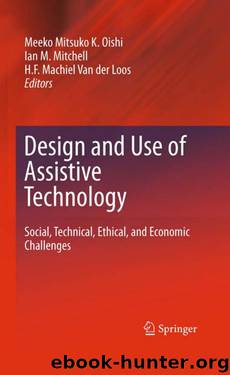Design and Use of Assistive Technology: Social, Technical, Ethical, and Economic Challenges by Meeko Mitsuko K. Oishi & Ian M. Mitchell & H. F. Machiel van Der Loos

Author:Meeko Mitsuko K. Oishi & Ian M. Mitchell & H. F. Machiel van Der Loos [Oishi, Meeko Mitsuko K. & Mitchell, Ian M. & Loos, H. F. Machiel van Der]
Language: eng
Format: epub
Tags: Biomedical, Engineering (General), Technology & Engineering, Springer, Automation, Medical, 9781441970305. 978-1-4419-7031-2", Computers, User Interfaces, General, Materials Science
ISBN: 9781441970305
Google: NEzEjwEACAAJ
Amazon: 1441970304
Publisher: Springer
Published: 2010-10-06T00:00:00+00:00
60
Nigel J. Livingston
CanAssist and appointed a full-time director. In addition, CanAssist has
been given dedicated space (approximately 6,000 square feet) that includes
laboratories, machine and fabrication shops and testing rooms.
CanAssist now receives approximately 200 requests a year for assistance.
The majority come from individuals and families, although a significant num-
ber come from professional care givers and health care agencies. We develop
over 40 new technologies a year, ranging from ball launchers (allowing dis-
abled users to “throw” a ball for their dog) to electromyographic (EMG)
based binary switches for software that allows users to easily browse the web
without use of a mouse. Two particularly successful CanAssist technologies
are the iPod adapter, PodWiz (Fig. 7.1), and an adjustable umbrella holder (Fig. 7.2).
Fig. 7.1 CanAssist’s PodWiz iPod adapter has been provided to many hundreds of users
with acute special needs. It allows them to control the music player with a wide variety
of input devices including a single button switch (shown in the photo). The PodWiz also
provides voice prompts, eliminating the need for users to read the iPod’s display
One key ingredient to CanAssist’s success is direct and regular contact
with its clients. In fact, our philosophy is that our clients are valuable team
members and their input is critical to the successful design of any device.
Another core tenet of the program is to engage students in CanAssist as
widely as possible. One of the main anticipated benefits is that students,
through their exposure to disability issues and the knowledge gained by hav-
ing direct contact with disabled individuals, will be highly motivated to pro-
mote and exercise inclusion when in a position to do so. Of course, at the
same time, students are provided with a unique, intellectually challenging and
deeply rewarding experience that can only reinforce their feelings of good cit-
izenship.
A third, and perhaps most critical element of the CanAssist model, is
the engagement and partnership with community. This extends from the
recruitment of individuals as volunteers to the forging of partnerships with
community agencies, government, and industry.
Download
This site does not store any files on its server. We only index and link to content provided by other sites. Please contact the content providers to delete copyright contents if any and email us, we'll remove relevant links or contents immediately.
Whiskies Galore by Ian Buxton(41880)
Introduction to Aircraft Design (Cambridge Aerospace Series) by John P. Fielding(33064)
Small Unmanned Fixed-wing Aircraft Design by Andrew J. Keane Andras Sobester James P. Scanlan & András Sóbester & James P. Scanlan(32743)
Craft Beer for the Homebrewer by Michael Agnew(18141)
Turbulence by E. J. Noyes(7936)
The Complete Stick Figure Physics Tutorials by Allen Sarah(7307)
Kaplan MCAT General Chemistry Review by Kaplan(6867)
The Thirst by Nesbo Jo(6828)
Bad Blood by John Carreyrou(6552)
Modelling of Convective Heat and Mass Transfer in Rotating Flows by Igor V. Shevchuk(6391)
Learning SQL by Alan Beaulieu(6211)
Weapons of Math Destruction by Cathy O'Neil(6146)
Man-made Catastrophes and Risk Information Concealment by Dmitry Chernov & Didier Sornette(5921)
Digital Minimalism by Cal Newport;(5664)
Life 3.0: Being Human in the Age of Artificial Intelligence by Tegmark Max(5474)
iGen by Jean M. Twenge(5366)
Secrets of Antigravity Propulsion: Tesla, UFOs, and Classified Aerospace Technology by Ph.D. Paul A. Laviolette(5309)
Design of Trajectory Optimization Approach for Space Maneuver Vehicle Skip Entry Problems by Runqi Chai & Al Savvaris & Antonios Tsourdos & Senchun Chai(5011)
Pale Blue Dot by Carl Sagan(4912)
